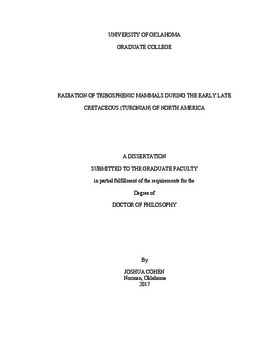| dc.description.abstract | Tribosphenic mammals from the medial Cretaceous (encompassing the Cenomanian to the Campanian (~98–80 Ma)) are rare elements of the fauna, typically recovered via bulk sampling and underwater screen washing. Southern Utah preserves nearly the entire Late Cretaceous rock record, resulting in decades of concerted effort in collecting samples from earlier units of the Cretaceous to compare with typical well-sampled Late Cretaceous rocks from the Campanian and Maastrichtian. Unfortunately, very few described faunas have yielded large samples of well-preserved specimens (with the exception of the early Cenomanian Mussentuchit Local Fauna), making comparisons difficult. Further complicating the problem of understanding mammalian faunal transitions from the Cenomanian to the Campanian are large gaps of time with very little specimens known. One such gap is the Turonian (~94–90 Ma), where very few terrestrial rock is exposed worldwide, due to a global marine transgression. Fortunately, over the past three decades, the late Turonian-aged Smoky Hollow Member of the Straight Cliffs Formation from southern Utah has yielded a large and diverse sample of terrestrial microvertebrates, including mammals. Herein, I describe the tribosphenic mammal fauna, breaking the chapters down taxonomically. In the first chapter, I describe the eutherians, which are rare elements of the fauna and were previously considered to have locally gone extinct in North America by the late Santonian (~82 Ma). At least three taxa are present, all of which are dentally advanced and known from later in the Cretaceous: Gypsonictops lewisi, Paranyctoides sp., and ?Zhelestidae. The presence of Gypsonictops is of particular interest because of its close phylogenetic proximity to Crown Group Placentalia, either just basal or nested within Afrotheria, giving support to the long-fuse hypothesis for placental origins. Paranyctoides sp. and ?Zhelestidae are both present in Asia at the same time, suggesting an immigration event may have occurred between North America and Asia by the late Turonian. The marsupialiform family Stagodontidae is described in the second chapter, including two new taxa: Fumodelphodon pulveris gen. et sp. nov. and Hoodootherium praeceps gen. et sp. nov. These genera represent a divergence in dietary specializations based upon premolar morphology. These dietary specializations include a more sectorial premolar (Hoodootherium praeceps) and a crushing premolar (Fumodelphodon pulveris). The specializations are reminiscent of the later Cretaceous stagodontids Eodelphis (sectorial) and Didelphodon (crushing), highlighting that this divergence occurred much earlier than previously thought. In the third chapter, I describe specimens referable to the superfamily Pediomyoidea, a family well known from the Campanian and Maastrichtian, and without clear antecedents from the medial Cretaceous. Two new taxa are described from the Smoky Hollow fauna, Scalaria diversicuspis gen. et sp. nov. and Scalaria aquilana sp. nov., representing basal members of the pediomyoid family Aquiladelphidae. Specimens from the Campanian and Maastrichtian previously referred to Aquiladelphidae are reviewed, with Aquiladelphis laurae confirmed as a member of the family, and a new taxon, Aquiladelphis analetris sp. nov. from the Judith River Formation is described and included. A specimen previously referred to Aquiladelphidae is formally described and placed with the pediomyoid family Glasbiidae, as a new species, Glasbius piceanus sp. nov. The final chapter finishes the alpha-level taxonomy of the Smoky Hollow fauna, describing the "alphadontid" marsupialiforms, including Varalphadon sp., Eoalphadon lillegraveni, Eoalphadon clemensi, Kokopellia musicus sp. nov., Apidelphys minuscularia gen. et sp. nov., and ?Anchistodelphys delicatus. The new occurrences from the Smoky Hollow fauna demonstrate a transitional mammalian fauna with elements from the earlier Cenomanian and the later Campanian faunas.
Vertebrate paleontology, Mammalia, Cretaceous, North America | en_US |
